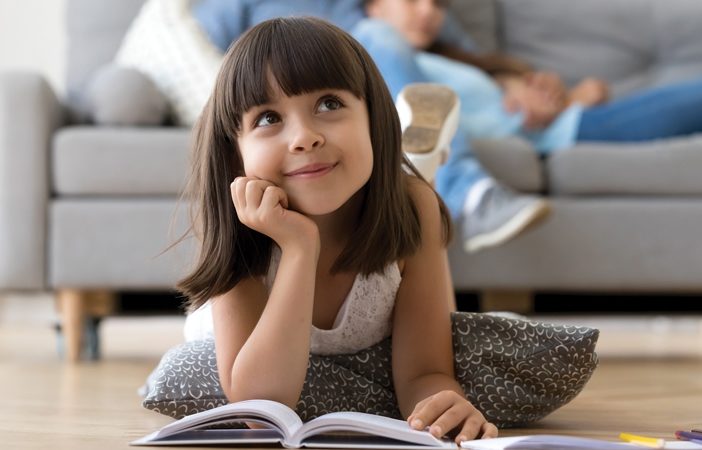
FIZKES/SHUTTERSTOCK.COM
Trading Clutter for Calm
When Denaye Barahona, of New York City, became a parent, she felt compelled to buy everything for her son. “We are inundated as a culture with so many products for our kids that it’s hard to differentiate what we need; it really wears us down,” she says.
While working on her Ph.D. in child development, Barahona discovered—both in research and personal experience—that kids actually thrive with less stuff. And so she began her journey toward minimalism by purging toys and clothes, eventually founding Simple Families.
Cary Fortin and Kyle Quilici, of San Francisco, believe time is better spent experiencing life with people than managing, organizing, cleaning and buying things. Their book New Minimalism: Decluttering and Design for Sustainable, Intentional Living is a call to adopt a more mindful life. Fortin says, “You decide first what you value, how you want to spend your days, how you want to feel, and then reflect these values in your physical space.”
“Minimalism is not about living in a tiny home and never owning more than 100 things; it’s about figuring out what brings value and purpose to your life and letting go of the rest,” says Atlanta’s Zoë Kim, author of Minimalism for Families: Practical Minimalist Living Strategies to Simplify Your Home and Life.
The Benefits
Time is precious, especially for parents. More free time is gained when a toy collection is significantly reduced, but other benefits result, as well. A 2018 University of Toledo study published in Infant Behavior and Development suggests toddlers engage in more focused and creative play when faced with fewer choices. “Kids who previously tore through bins or who didn’t care about their belongings immediately begin engaging with toys more appropriately and for longer periods of time,” says Barahona, the author of Simple Happy Parenting: The Secret of Less for Calmer Parents and Happier Kids.
Research also indicates that our limited stores of willpower are depleted more quickly when we are flooded with decisions. “When you have less stuff in a room and less choices to make, your mental state actually improves—you have more clarity and can focus better,” she says. “Because kids are so much more easily stimulated, they feel the impact of a chaotic room even more than adults.”
~Denaye Barahona
Minimalism also arms children with self-reflection tools and introduces them to the process of letting go and donating. “They learn to ask ‘Am I enjoying this? Could I repurpose it?’ while understanding that some things we can mend and enjoy for long periods of time, and other things we outgrow—which we can then give away,” says Fortin.
Where to Start
Experts agree that in family households, the shift toward minimalism should begin with the adults. “It gives them time to understand how the process feels and models the behavior for their children,” says Fortin.
Barahona streamlines her home by focusing on active spaces. “Active items are the things you use regularly, such as your two favorite pairs of jeans—not the 13 pairs you rarely wear.” When active and storage items accumulate in the same space, the need to sort through extra “stuff” wastes time and energy, she says. “We’ve all lost our keys when we’re already running late and then suddenly we’re yelling at our kids. Simplifying so we can prevent these scenarios positively impacts our mood and our ability to be present with our kids.”
Although the decluttering process starts with the parents, children should be involved as much as possible, and in a positive light. “Kids don’t like cleaning up, but with ongoing conversations and small consistent shifts, children see how less stuff can lead to more time for enjoyable activities,” says Kim.
Minimalist strategies can be applied across many realms of life, such as scaling back the family calendar and hovering less as a parent. “Family life always seems to speed up, but we can break the cycle of busy by scheduling blank time. Being intentional with time goes hand-in-hand with minimalism,” says Quilici.
To stay inspired, find social media pages and websites to follow for ideas. “You’re going to hit roadblocks, so it’s important to surround yourself with inspiration,” Kim says. “Now that I’ve let go of the lifestyle I thought I needed, it’s nice to have less, but it’s even better to want less.”
Meredith Montgomery publishes Natural Awakenings of Gulf Coast Alabama/Mississippi.
How to Keep the Clutter Out
Set Physical Boundaries
Establish rules for what can be stored, where and how much. Childhood keepsakes, artwork, craft supplies and school papers can accumulate quickly. Limit how much can be kept by designating a box for toys or a wall to display art. Digital photos allow the memories to be kept without taking up physical space.
Create a ‘Why’ Statement
Determine how we want to feel in a space, document it and refer to it for inspiration and guidance, especially when feeling frustrated or lost.
Practice ‘One In, One Out’
Every time a new item enters the home, an old item needs to leave.
Buy Better Toys
The right toys invite kids to play more creatively over many years. Character toys may invoke more initial joy and giddiness, but a great block set will manifest longer-lasting value for kids.





